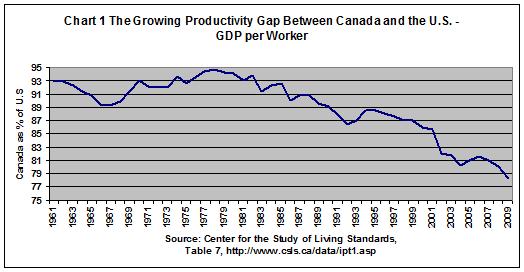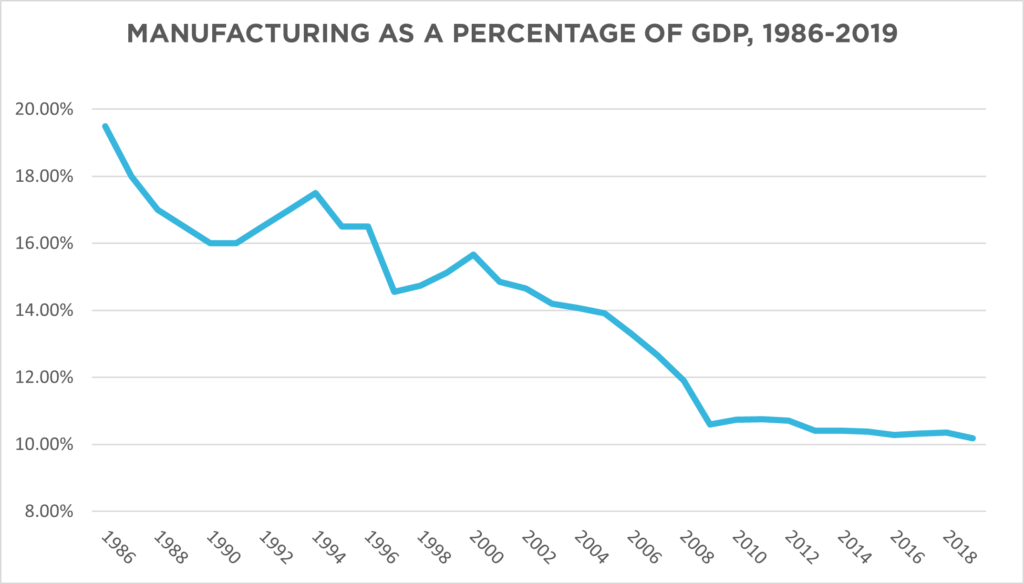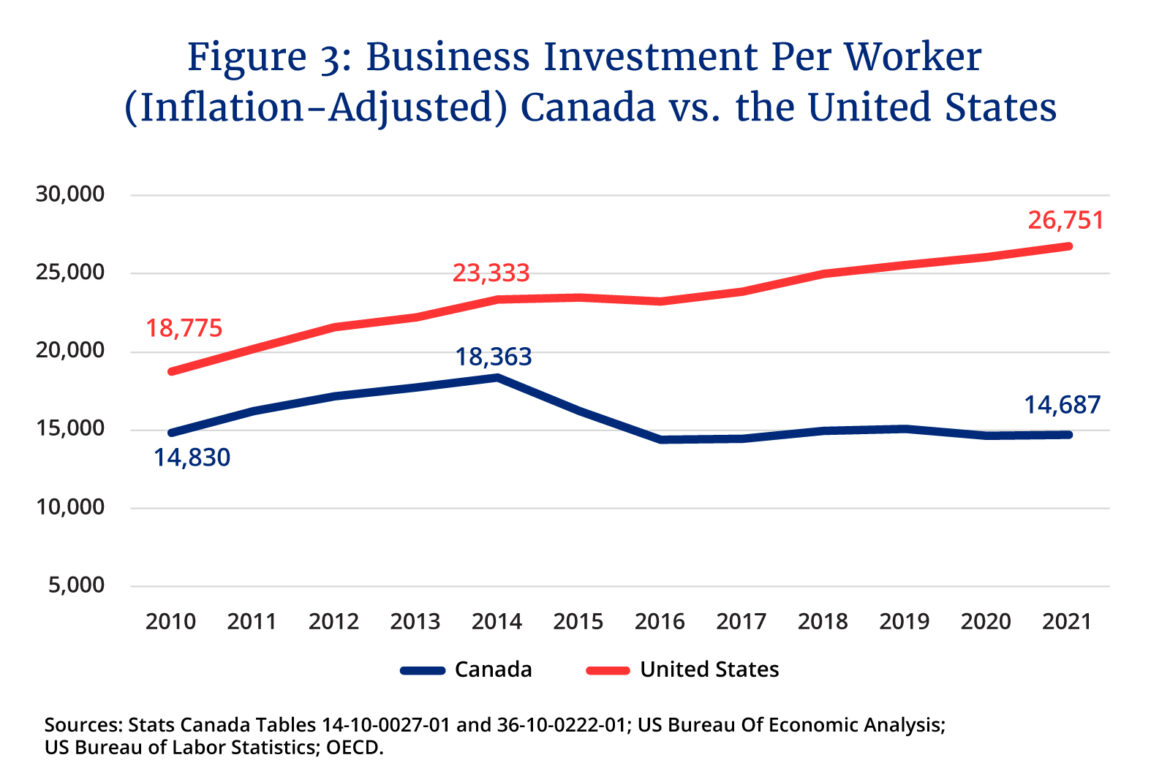
For the first time since the Great Depression, labour productivity is falling in Canada. The Bank of Canada has called this “an emergency” and various bourgeois commentators are scrambling for an explanation. However, all of these analysts blame secondary factors and miss the elephant in the room: the system itself.
Labour productivity is essentially the amount of economic output per work hour. Developments in labour productivity form the bedrock of any society. For the entirety of humanity, everything from art, culture, and politics has rested on—in the last analysis—our ability to develop the productive forces, of which labour productivity is a central measure. The fact that this is decreasing indicates that something is deeply wrong with Canadian capitalism.
As Marx described, the capitalist system played a historically progressive role in the past, smashing feudal fetters and massively developing the productive forces. For a long time, Canada was one of the most productive economies in the world. Manufacturing and resource extraction were the mainstays of the Canadian economy, with the country boasting some of the most productive manufacturing plants in the world. This contributed to Canada being an economic powerhouse, developing labour productivity year after year. But this trend has been completely reversed.
Deputy director of the Bank of Canada, Carolyn Rogers explained that “Back in 1984, the Canadian economy was producing 88 per cent of the value generated by the U.S. economy per hour.” She continued: “By 2022, Canadian productivity had fallen to just 71 per cent.” Labour productivity has also fallen in absolute terms, declining by 0.3 per cent in the last five years.

Speaking at the Canada Growth Summit on April 11, Trevor Tombe—an economics professor at the University of Calgary—stated that “the scale of the challenge, the speed of it worsening, and the importance of addressing it are now bigger than in most of our lifetimes.”
But this is not an abstract discussion. A fall in labour productivity inevitably leads to a fall in living standards. This impacts the working class and poor the hardest. And this is having an impact on consciousness, as millions draw the conclusion that capitalism needs to be done away with.
Crisis of overproduction
The fundamental cause of the capitalist crisis is overproduction. As capitalists compete with each other for market share, they are compelled to invest to produce feverishly more and faster.
At the same time, in the productive process, workers are not paid the full value of their labour. Therefore, it is impossible for the consumer market (made up principally of workers) to buy all of the commodities produced.
As Marx explained in Capital Volume 3, “The ultimate reason for all real crises always remains the poverty and restricted consumption of the masses as opposed to the drive of capitalist production to develop the productive forces.”
Left up to itself, crises inevitably break out as there are too many goods flooding a limited market. In response the capitalists pull their capital from investment, closing factories, destroying the productive forces. But this only further exacerbates the crisis.
However, the capitalists have all sorts of methods they use to attempt to overcome this problem. And it is precisely the way in which the crisis of overproduction has expressed itself in Canada, and the various policies the bourgeoisie implemented to deal with it, that have directly led to the current productivity crisis.
Delaying the inevitable
After almost three decades of boom following WWII, the system hit a wall with the world recession of 1973. In an attempt to overcome the repercussions of this, the bourgeoisie in Canada used debt to expand the market beyond its natural limits. Since workers’ wages were not enough, they were encouraged to go into debt to continue to buy like never before. Huge mortgages, credit cards, and all manner of personal loans became widespread as people used the money of tomorrow to help them pay to survive in the present. But this only delayed the inevitable.
Debt cannot be expanded forever without consequences. The limits of this policy were even highlighted by the former head of the Bank of Canada, Mark Carney, back in 2012 when he said, “We cannot grow indefinitely by relying on Canadian households increasing their borrowing relative to income.” Since then, the problem has only gotten worse.
Today, debt has reached astronomical levels. Consumer debt was around $16 billion in 1961 but today it stands at a staggering $2.94 trillion—around 50 per cent more than the GDP of the entire country.
The subprime mortgage crisis of 2008–2009 was a rude awakening. All of the policies that the bourgeoisie had implemented to deal with the effects of the crisis now created an even bigger crisis which expressed itself in a crisis of debt.
In response, capitalists withdrew from investment in productive industry. This created the phenomenon of “capital hoarding,” where capitalists preferred to sit on their money than invest it in production. At its height, this reached $1.5 trillion of dead money sitting in corporate bank accounts. Manufacturing declined. As a percentage of GDP, it went from 16 per cent in 2000 to just 10 per cent today.

Increasingly, the state has stepped in, using government money to bolster production. The two clearest examples of this are the Transmountain pipeline and the electric vehicle plant Stellantis. In the case of the Transmountain pipeline, the government has dished out $21.4 billion for this project. In the case of the Stellantis battery plant, the $28.2 billion state subsidy amounted to $4 million per job! Why we even need the capitalists at this point is anyone’s guess.
The government also bails out the capitalists every time they’re in trouble. We clearly saw this in 2008-9 and in 2020, where they swooped in to save the system. This has led the federal debt to more than double, going from $600 billion to over $1.2 trillion in the last decade. When we include all layers of government debt, we get the staggering figure of $2.8 trillion! At all levels, the Canadian economy is weighed down with an immense amount of debt.
But these measures have only created other problems. While we are constantly told that capitalists deserve the profits they make because “they take all of the risk,” this is clearly not true as every time there is a collapse, the state comes to the rescue. This has contributed to the productivity crisis by artificially keeping alive companies that would otherwise fail. Canada now has a larger share than many other countries of what is known as zombie firms—companies who would otherwise go under if it wasn’t for state support.
According to Statistics Canada, letting these companies fail would raise productivity by 5 per cent. But that is not such a simple question. Small businesses which employ less than 100 employees, in total employ nearly 12 million workers. Nine-hundred thousand of these businesses accepted interest free loans from the government as a form of COVID support. As the government is now attempting to withdraw these supports, one fifth have failed to repay their loans. Already there has been a spike in bankruptcies which in and of itself could spark an economic collapse which would act as a drag on productivity. Everything hangs in a tenuous balance.
The parasitism of the bourgeoisie
The picture we have before us is a decrepit system, with the bourgeoisie propped up by the state, refusing to invest in production.
But increasingly, many capitalists are finding ways to turn a profit without getting their hands dirty in the productive process. While the bourgeoisie are technically always parasites, with the value created by the workers being appropriated by the capitalists, now the tendency is to not even bother with production at all!
Speculative bubbles of all manner have become common with hundreds of billions of dollars sloshing around in the market. In Canada, this has manifested itself in one of the largest housing bubbles of all time. This has led to Real Estate, Rental and Leasing—an entirely unproductive industry—to become the largest industry in the country.
As more capitalists prefer to speculate rather than invest in production, business investment per worker declined from $18,363 to $14,687 from 2014 to 2021. Compared with the U.S., businesses in Canada went from investing approximately 79 cents per worker (for every dollar invested in the U.S.) in 2014 to only 55 cents in 2021. According to the OECD, in gross fixed capital formation (which represents investment that adds value in the economy), Canada came in 44th out of the top 47 economies from 2015 to 2023.

It should therefore be no surprise that productivity of labour is falling. The result of a sustained decline in labour productivity will inevitably be a drop in living standards. This is a damning example of the failure of the capitalist system.
Socialism or barbarism
But the bourgeoisie can no longer delay the inevitable. All of the methods they used in the past to overcome the contradictions of their system have now run out. Crisis stares them in the face, no matter what they do.
Faced with an economy weighed down by debt and the system being propped up by the state, many politicians and economists are drawing the conclusion that a brutal reckoning is necessary.
This is probably best summed up by Pierre Poilievre who stated in April this year that “I will end corporate handouts to all industries. I do not believe in corporate handouts. We are the only party that stands against corporate welfare. We believe businesses should make money, not take money. We believe in the free market, not state capitalism.”
Echoing a similar point, David Rosenberg, writing for the Financial Post, says that the current government has put “too much emphasis on government intervention and less on promoting pro-productivity business investment and export competitiveness.”
Connected to this, both Poilievre and economists like Rosenberg have gone on a crusade against government spending. Poilievre blames government spending for inflation. Rosenberg explains that “There has been no capital deepening or productivity growth in Canada in eons because the massive spending at the government level has continued to crowd out private-sector investment.”
Rosenberg’s solution, much like Poilievre’s, is to return to the policies of Thatcher, Mulroney and Reagan, calling Mulroney “the most effective prime minister of the 20th century.”
His solution, similar to that of Mulroney, is that the federal government should privatize state companies, slash public spending, carry out mass layoffs in the public sector and lower corporate tax rates. Apparently only after we do this will the capitalists invest.
While some may think this is a fringe libertarian idea, think again. The political elite, including Bank of Canada representatives, are all pushing in this direction.
Just last fall, Bank of Canada governor Tiff Macklem bemoaned government spending, stating that “It would be helpful if monetary and fiscal policy was rowing in the same direction.” In normal person speak, this means cuts to government spending—which is the program of Pierre Poilievre.
But this so-called “solution” shows what capitalism has in store for us. Either the bourgeoisie continue their current policy in which inflation erodes wages, interest rates cause mortgage payments to soar, and productivity is falling—or they cut social spending, carry out mass layoffs, privatize state assets, and attack the labour movement.
Pick your poison. In both cases, the working class foots the bill.
But eventually the bourgeoisie may be able to find a way to stabilize their system again. The question is “at what cost?” In the words of Rosa Luxemburg, the choice before us is “socialism of barbarism.”
Long ago, Marx explained that the ability of any given socio-economic system to maintain itself is based on its ability to develop the productive forces of society. When it fails to do so, this has knock-on effects throughout society, and, in the words of Marx, “Then begins an era of social revolution.” This is precisely what we are seeing today. This is why we are organizing Communists in the Revolutionary Communist Party: to prepare for revolution.
With the most educated workforce in the world and immense amounts of wealth and productive capacity, this crisis is wholly the product of capitalism. Under a workers’ government, we would expropriate these parasites and use this productive wealth to invest massively to produce for human need. Only through a socialist plan of production could we unleash the productive forces of the working class in Canada. We could easily begin to tackle all of the massive problems facing humanity today.

